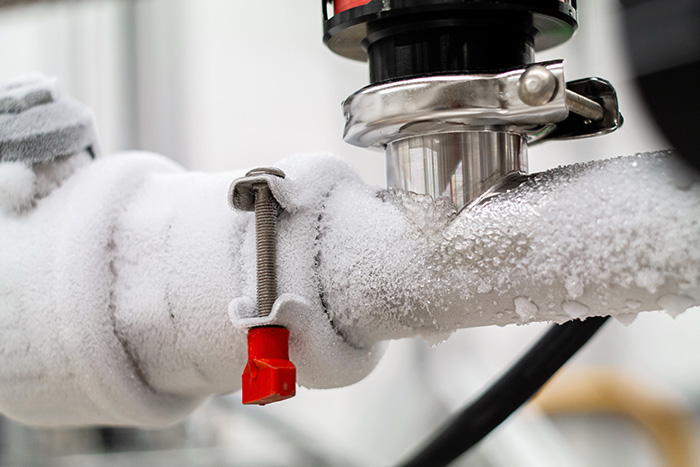Ways to Protect Your Pipes from Freezing Damage: Important Tips
Ways to Protect Your Pipes from Freezing Damage: Important Tips
Blog Article
We've stumbled upon this great article on Helpful Tips to Prevent Frozen Pipes this Winter directly below on the internet and concluded it made good sense to discuss it with you on this page.

Cold weather can damage your plumbing, particularly by freezing pipes. Here's how to prevent it from occurring and what to do if it does.
Introduction
As temperature levels decrease, the danger of frozen pipelines rises, potentially resulting in costly repair work and water damage. Recognizing exactly how to prevent icy pipes is important for property owners in cool climates.
Prevention Tips
Protecting at risk pipelines
Wrap pipes in insulation sleeves or make use of warmth tape to protect them from freezing temperature levels. Focus on pipes in unheated or outside locations of the home.
Heating methods
Maintain interior rooms appropriately heated, particularly locations with plumbing. Open cabinet doors to permit warm air to distribute around pipelines under sinks.
Exactly how to identify icy pipelines
Try to find lowered water flow from faucets, uncommon odors or noises from pipes, and noticeable frost on revealed pipes.
Long-Term Solutions
Architectural modifications
Take into consideration rerouting pipes far from outside wall surfaces or unheated areas. Add added insulation to attic rooms, cellars, and crawl spaces.
Updating insulation
Purchase high-grade insulation for pipes, attic rooms, and wall surfaces. Appropriate insulation helps maintain regular temperature levels and decreases the danger of frozen pipelines.
Protecting Exterior Plumbing
Yard pipes and outdoor taps
Disconnect and drain pipes yard hose pipes prior to winter. Set up frost-proof spigots or cover exterior taps with insulated caps.
Recognizing Frozen Pipes
What triggers pipelines to ice up?
Pipes ice up when exposed to temperature levels listed below 32 ° F (0 ° C) for expanded durations. As water inside the pipes freezes, it broadens, taxing the pipe walls and potentially triggering them to break.
Risks and damages
Icy pipelines can lead to water system disturbances, residential or commercial property damage, and expensive repair work. Burst pipelines can flooding homes and create comprehensive structural damage.
Signs of Frozen Piping
Identifying icy pipes early can stop them from rupturing.
What to Do If Your Pipes Freeze
Immediate actions to take
If you suspect frozen pipelines, keep taps open to soothe pressure as the ice thaws. Make use of a hairdryer or towels soaked in warm water to thaw pipes slowly.
Final thought
Preventing icy pipes requires aggressive procedures and fast actions. By understanding the reasons, indicators, and safety nets, home owners can protect their plumbing during cold weather.
6 Proven Ways to Prevent Frozen Pipes and Protect Your Home
Disconnect and Drain Garden Hoses
Before winter arrives, start by disconnecting your garden hoses and draining any remaining water. Close the shut-off valves that supply outdoor hose bibs and leave the outdoor faucet open to allow any residual water to drain. For extra protection, consider using faucet covers throughout the colder months. It’s also important to drain water from any sprinkler supply lines following the manufacturer’s directions.
Insulate Exposed Pipes
Insulating your pipes is an effective way to prevent freezing. Pipe insulation is readily available at home improvement stores and is relatively inexpensive. Pay close attention to pipes in unheated areas such as the attic, basement, crawl spaces, or garage. Apply foam insulation generously to create a buffer against the cold. You can also wrap your pipes in heat tape or thermostat-controlled heat cables for added warmth.
Seal Air Leaks
Inspect your home for any cracks or openings that could let in cold air. Seal any holes around the piping in interior or exterior walls, as well as the sill plates where your home rests on its foundation. Additionally, make sure to keep your garage door closed unless you’re entering or exiting. Leaving it open creates a significant air leak that can lead to frozen pipes.
Allow Warm Air Circulation
During cold snaps, it’s essential to allow warm air to circulate evenly throughout your home. Leave interior doors ajar to promote better airflow. Open kitchen and bathroom cabinets to help distribute heat consistently around the rooms. If you have small children or pets, be sure to remove any household chemicals or potentially harmful cleaners from open cabinets for safety.
Let Faucets Drip
A small trickle of water can make a big difference in preventing ice formation inside your pipes. When temperatures drop significantly, start a drip of water from all faucets served by exposed pipes. This continuous flow helps prevent the water from freezing. Additionally, running a few faucets slightly can relieve pressure inside the pipes, reducing the chances of a rupture if the water inside does freeze.
https://choateshvac.com/6-proven-ways-to-prevent-frozen-pipes-and-protect-your-home/

Hopefully you liked our article about How to Prevent Your Pipes From Freezing. Thanks a lot for finding the time to read our short article. Enjoyed reading our review? Please share it. Help others find it. I take joy in your readership.
Click Here Report this page